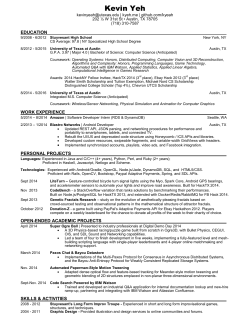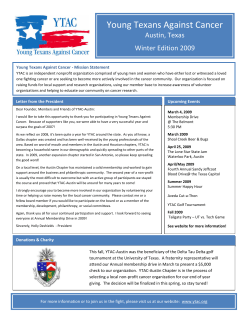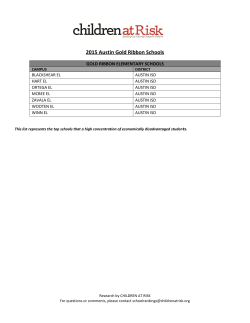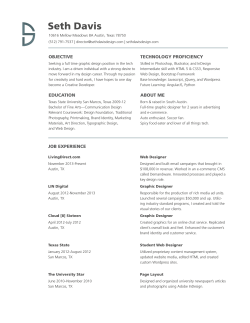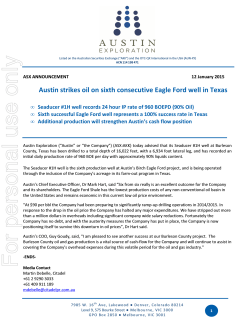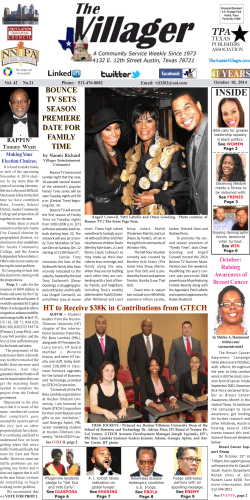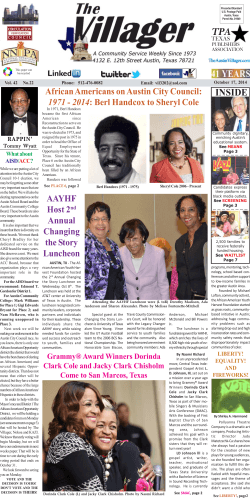
Austin Aligns for Boys and Young Men of Color
Report on the SXSWedu Community Dialogue Austin Aligns for Boys and Young Men of Color A City-wide Conversation about President Obama’s Initiative, My Brother’s Keeper (MBK) April 1, 2015 Event hosted by SXSWedu and co-sponsored by Austin Community College, Austin Independent School District, Huston-Tillotson University, KLRU-TV, the Mayor of the City of Austin, and The University of Texas at Austin R E P O R T O N T H E S X S We d u C O M M U N I T Y D I A L O G U E Table of Contents Introduction......................................................................................................................... 2 Commitment Cards...................................................................................................... 2 Roundtable Discussions......................................................................................... 3 Question #1............................................................................................................................ 3 Question #1 Themes and Recommendations................................................................... 4 1. An early start.............................................................................................................. 4 2. Parental and family involvement............................................................................... 4 3. Mentors and teachers................................................................................................ 4 4. Exposure to opportunities......................................................................................... 5 5. Data and outcomes.................................................................................................... 5 6. Health Access............................................................................................................. 5 7. Post-secondary education and training.................................................................... 5 8. Safety from crime....................................................................................................... 6 Question #2............................................................................................................................ 7 Question #2 Themes and Recommendations................................................................... 7 1. Funding........................................................................................................................ 7 2. Tech and business resources.................................................................................... 7 3. Policy solutions........................................................................................................... 7 4. Program collaboration............................................................................................... 7 5. Solving systematic segregation................................................................................. 7 6. Education pipeline...................................................................................................... 8 7. Extracurricular activities............................................................................................ 8 8. Proactive services...................................................................................................... 8 Next Steps............................................................................................................................. 9 Recommendations................................................................................................................ 9 Acknowledgements...................................................................................................10 AU S T I N A L I G N S FO R B OYS A N D YO U NG M E N O F C O L O R | A P R I L 2015 1 R E P O R T O N T H E S X S We d u C O M M U N I T Y D I A L O G U E Introduction Nearly one year ago, President Obama launched the My Brother’s Keeper (MBK) initiative and challenged every city to address the significant challenges that young men of color face. On March 10, 2015, over 100 Austin educators, city government officials, philanthropists, community and non-profit leaders gathered for a two-hour community dialogue at the SXSWedu conference to discuss the lives of the city’s boys and young men of color. The event was was co-sponsored by Austin Community College, Austin Independent School District, Huston-Tillotson University, KLRU-TV, the Mayor of the City of Austin, and The University of Texas at Austin. Austin Mayor Steve Adler delivers the opening address at the SXSWedu event. The event included opening remarks by Austin Mayor Steve Adler and a keynote address by Senior Director of Cabinet Affairs for My Brother’s Keeper Michael D. Smith. The speeches were followed by a panel Of those that filled out their card, the majority discussion moderated by Dr. Gregory Vincent (Vice selected the formation of a city-wide MBK task force President, UT-Austin) and featuring Dr. Richard as a preferred next step, followed by a formal City Armenta (Associate Vice President, Austin Commu- of Austin commitment and a policy scan. Many nity College), Dr. Paul Cruz (Superintendent, Austin attendees selected more than one option. Independent School District), Johnny Hill (UT-Austin graduate), Dr. Leonard Moore (Senior Associate Vice SXSWedu COMMITMENT CARD RESPONSES President, UT-Austin), and Dr. Victor Sáenz (ExecOutcome/Action tive Director, Texas Education Consortium for Male Count % of Cards Collected Students of Color). A formal City of Austin 37 77% 32 67% 39 81% 10 21% commitment to MBK Commitment Cards A policy scan about issues Guests were asked to fill out a Commitment Card affecting Austin’s boys and pledging to help Austin’s boys and young men of young men of color color and what outcomes they would like to see The formation of a city- as a result of the event’s dialogue. They were also wide MBK task force that asked to list what programs and resources they or develops recommendations their organizations would be willing to leverage for and a local action plan a community-wide initiative. Of all attendees, 48 completed a card (46% of recorded attendees). Other AU S T I N A L I G N S FO R B OYS A N D YO U NG M E N O F C O L O R | A P R I L 2015 2 R E P O R T O N T H E S X S We d u C O M M U N I T Y D I A L O G U E Roundtable Discussions regardless of who they are, where they come from, or the circumstances into which they are born. Community members were asked to discuss two The six goals of the My Brother’s Keeper challenge are: common questions in roundtable discussions. Prevalent themes and recommendations from 1. To ensure all children enter school cognitively, the discussions are listed below. Full roundtable physically, socially and emotionally ready discussions have been archived on the The University of Texas Longhorn Campaign for Men of Color at 2. To ensure all children read at grade level by 3rd http://ddce.utexas.edu/menofcolor. grade 3. To ensure all youth graduate from high school Question #1 4. To ensure all youth complete post-secondary In September 2014, President Obama issued a education or training challenge to cities, towns, counties and tribes across 5. To ensure all youth out of school are employed the country to become “MBK Communities.” The MBK Community Challenge encourages communities 6. To ensure all youth remain safe from violent crime (cities, rural municipalities, and tribal nations) to implement a coherent cradle-to-college-and-career Of these national goals, which of these seem most strategy for improving the life outcomes of all young relevant to Austin? What issues relevant to Austin’s people to ensure that they can reach their full potential, young men of color are missing from this list? AU S T I N A L I G N S FO R B OYS A N D YO U NG M E N O F C O L O R | A P R I L 2015 3 R E P O R T O N T H E S X S We d u C O M M U N I T Y D I A L O G U E Question #1 Themes and Recommendations (Not ranked in order of importance) 1. An early start ▐▐ “Ensure all children enter school cognitively, physically, socially and emotionally ready” (MBK goal #1) was frequently cited as most relevant. ▐▐ “Ensure all children read at grade level by 3rd Michael D. Smith, Special Assistant to President Obama and Senior Director of Cabinet Affairs for My Brother’s Keeper, gives the keynote address. grade” (MBK goal #2) was also mentioned. ▐▐ Change the mindsets of young men of color early in life with effective teachers and mentors. 3. Mentors and teachers ▐▐ Serve boys of all ages, pre-K through post- ▐▐ Evaluate if Austin’s mentors and teachers mirror secondary. the demographics of the populations they serve. ▐▐ Develop positive, long-term relationships with Respondents said: boys and young men early. “What might be missing from Austin are 2. Parental and family involvement educators that look like the populations they serve.” ▐▐ Involve parents and family when planning for youth success. ▐▐ Establish direct and consistent mentorship with ▐▐ Incorporate the role of fatherhood, family boys and young men. structure, and the impact of a young man’s ▐▐ Include mentors, teachers, and administrators in personal home situation in solutions for these solutions. young men. Respondents said: Respondents said: “The degree to which these students are unaware “When we reach the parent, we reach the child.” of their opportunities needs to be addressed. There are a lot of youth who want to be someone. “Nobody is a better advocate than a child’s own Yet, that information symmetry does not sink parent; too often we say that parents are the problem.” down into their community of how to be someone “Parents are super important, but sometimes they providing guidance into the community this can are a risk factor too.” be addressed.” and reach their goals. Perhaps through mentors AU S T I N A L I G N S FO R B OYS A N D YO U NG M E N O F C O L O R | A P R I L 2015 4 R E P O R T O N T H E S X S We d u C O M M U N I T Y D I A L O G U E 5. Data and outcomes “We need to step in and provide the non-cognitive ▐▐ Prioritize the collection and organization of support that students aren’t receiving at home. data and outcomes measurement at all ages to Mentorship is often the key to this.” successfully evaluate the gaps and find solutions. 4. Exposure to opportunities Respondents said: ▐▐ Make existing resources available and “Be honest about the statistics. Once we have the understandable to organizations and community real statistics, we can create real solutions.” members. “The first one would be data, we don’t have a database that starts at pre-K and goes through Respondents said: post-secondary education.” “The biggest challenge is the connectivity. It is about information. Almost like a clearinghouse. “The idea of continuing to track outcomes and We need to connect families.” examining how we define outcomes is particularly relevant for school districts.” ▐▐ Increase awareness and access to job opportunities through field trips to Austin 6. Health access businesses and nonprofits. ▐▐ Ensure boys and young men of color are healthy and have access to healthcare. Respondents said: “If you are not healthy, you will not show up.” ▐▐ Address the mental health needs of students. 7. Post-secondary education and training ▐▐ “Ensure all youth complete post-secondary education or training” (MBK goal #4) was mentioned. Dr. Gregory J. Vincent, Vice President of Diversity and Community Engagement at The Univeristy of Texas at Austin, moderates a panel discussion with students and leaders from the Austin Independent School District, Austin Community College, and UT-Austin. AU S T I N A L I G N S FO R B OYS A N D YO U NG M E N O F C O L O R | A P R I L 2015 5 R E P O R T O N T H E S X S We d u C O M M U N I T Y D I A L O G U E ▐▐ Ensure schools have a friendly environment for Respondents said: students of color. “Goal number four jumps out because when you ▐▐ Give guidance and create safe outlets for young look at Austin’s economy, many of these jobs are men if they have gone down a wrong path. unfilled and employers can’t find people to fill these positions. However, there are so many people unemployed so number four addresses this gap.” Respondents said: ▐▐ Promote early intervention as it relates to “Provide them life coaches without fear of exposure to higher education. Build connections repercussions for messing up. If they’re selling between alienated communities and institutions drugs or doing anything wrong, we need them of higher education thinking of cultural to have someone they feel comfortable talking to relevance and relatability for students and without fear of punishment.” parents. “There needs to be a connection that lets these kids know, ‘We’re not going to let you fail.’” Respondents said: “From pre-K through 3rd grade there is no focus on college. It does not start until 4th or 5th grade. That is a missed opportunity for students who lack that intervention to see higher education as a goal.” “High school graduation is not enough anymore.” 8. Safety from crime ▐▐ “Ensure all youth remain safe from violent crime” (MBK goal #6) was mentioned. Respondents said: “Austin doesn’t have a safety issue in terms of violent crimes. We have to create a place where boys of color feel comfortable and included within the general society. We have to provide a quality education, and safety net programming.” “Change the way we deal with the punishment of youth. Build self-advocates so that they know how to…advocate for themselves.” AU S T I N A L I G N S FO R B OYS A N D YO U NG M E N O F C O L O R | A P R I L 2015 6 R E P O R T O N T H E S X S We d u C O M M U N I T Y D I A L O G U E Question #2 3. Policy solutions What are promising programs and initiatives of your ▐▐ Recognize the differences in impact between organization (or others) that currently support boys programs and policy, and the importance of and young men of color in Austin? What other resources positive change in both. Programs cannot can Austin leverage in order to maximize their impact? succeed without systemic change through policy What gaps still exist for Austin’s boys and young men of implementation. color, and how can we address these gaps? Respondents said: Question #2 Themes and Recommendations “One example (of a policy change) is a tax incentive given to companies that move to Austin (Not ranked in order of importance) and invest in community programs that align with 1. Funding the field of business – i.e. tech companies that fund STEM programming in schools.” ▐▐ Increase funding for programs and ensure responsible spending of those funds. 4. Program collaboration Respondents said: ▐▐ Promote program collaboration for the success of young men of color. Collectively address their “Look to city to help with funding.” needs to strengthen opportunity and impact. 2. Tech and business resources Respondents said: ▐▐ Engage Austin’s tech resources to improve ease “Collective impact – instead of siloed programs.” of access to information. These technological resources can provide foundational tools for “We need to do things more comprehensively and reaching young men of color. in a coordinated, comprehensive way.” Respondents said: 5. Solving systemic segregation “We are a tech savvy city. How do we leverage that ▐▐ Address systemic racism and segregation to to connect teachers, families, and resources?” ensure equity for boys and young men of color through public policy solutions. “As the #1 tech city in the nation, there is room to strengthen business partnerships within this field reaching students and parents. A city call to action related to this might have significant impact towards the effort of moving us down the list of cities with the highest economic segregation.” AU S T I N A L I G N S FO R B OYS A N D YO U NG M E N O F C O L O R | A P R I L 2015 7 R E P O R T O N T H E S X S We d u C O M M U N I T Y D I A L O G U E 7. Extracurricular activities Respondents said: ▐▐ Connect young men of color with extracurricular “There is a need to discuss systemic issues. While activities in their communities. Community- roundtable discussions are important, there needs based and nonprofit organizations can provide to be systemic attunement to inclusion. How are resources to young men that schools cannot. we addressing systemic institutionalized racism?” “Level the playing field.” Respondents said: “95% of kids who come to court do not participate in any extracurricular activities – let’s get them 6. Education pipeline involved.” ▐▐ Strengthen the education pipeline. ▐▐ Engage a student’s passions to complement his Respondents said: academic excellence. “We don’t have diversity in our schools. What is the university doing that will create a pipeline to increase the number of teachers?” 8. Proactive services “Strengthen the education pipeline by initiating ▐▐ Provide services to young men of color before earlier intervention through community programs they enter into negative circumstances in their already in existence.” school or community. Many programs focus on helping youth who are placed in situations where they have no alternatives. Focusing only on these programs can create the sense of a reactionary deficit model rather than a proactive one. Respondents said: “One particular program focuses on young people of color in trouble. Students are unable to receive services until they ‘do something wrong’. So, can we provide services to students in a proactive fashion?” AU S T I N A L I G N S FO R B OYS A N D YO U NG M E N O F C O L O R | A P R I L 2015 8 R E P O R T O N T H E S X S We d u C O M M U N I T Y D I A L O G U E Next Steps RECOMMENDATIONS Using Collective Impact to Move Austin Forward These next steps are based on recommendations for city governments and community partners outlined by the My Brother’s Keeper initiative Community Challenge. The City of Austin and Travis County should: ▐▐ Formally accept the My Brother’s Keeper Community Challenge issued to local executive and community allies. This can include: • Announcing acceptance of the challenge with a press release or media statement • Designating a staff member to lead Austin MBK efforts • Designating a city-wide MBK task force • Determining which MBK priorities are most This community dialogue demonstrated that relevant to Austin Austin and Travis County have many community • members and organizations dedicated to improving Enlisting community partners and stakeholders in these efforts the lives of boys and young men of color. The city has community partners analyzing the challenges ▐▐ Convene local action summit(s) similar to the facing this population, research partners producing SXSWedu event, but with an issue-specific evidence-based methods to address those challenges, agenda. and community programs engaging young men of color on a daily basis. Austin has the opportunity ▐▐ Conduct a policy scan reviewing local policies, to unite and inform the work of these stakeholders programs, and practices so they may better serve by declaring city-wide goals and commitments the needs of Austin’s young men of color. for the city’s young men of color, thereby focusing ▐▐ Collect data about issues that affect young local resources as well as using collective impact to men of color and aggregate this data through a address areas that stakeholders have not been able to community dashboard. address on their own. ▐▐ Launch a plan of action based on policy and data review. AU S T I N A L I G N S FO R B OYS A N D YO U NG M E N O F C O L O R | A P R I L 2015 9 R E P O R T O N T H E S X S We d u C O M M U N I T Y D I A L O G U E Acknowlegements ROUNDTABLE MEMBERS TABLE 1: Morgan Craven, Kazique Prince, Gina Hinojosa, Jerel Booker, Jessica Khalaf TABLE 2: Harrison Keller, Raul Alvarez, Cheryl Bradley, Robert Bachicha, Johnny Hill, Betty Johnson, Matt Chester TABLE 3: Montserrat Garibay, Stacey Archer, Patrick Ockletree, Genevieve Van Cleve, Victor Sáenz, Juan Lopez TABLE 4: Eleanor Thompson, Richard Armenta, Susan Dawson, Crystal Martinez, Suki Steinhauser, Martin Smith TABLE 5: Kelly Crook, Margo Dover, Sterling Lands II, Gigi Edwards, Erica Cuevas TABLE 6: Melissa Chavez, Damon Luckett, Meg Clifford, Gabriel Estrada, Anthony Heaven TABLE 7: Suzanne Wallen, Mary Ellen Pietruszynski, Teddy McDaniel, John Hernandez, Gene Willis , Terrence Allen, Jacob Freire, Dallawrence Dean TABLE 8: Terrance Eaton, Nelson Linder, Stephanie Hawley, Alberto Gonzalez, Janice Johnson Shephard, Yvonne Williams, Mike Gutierrez TABLE 9: Taco Price, Leal Anderson, Rashaanna Lewis, Monica Sanchez, Tiffany Woody, Joseph Gallardo TABLE 10: Linda Medina-Lopez, Carolyn Goldstan, James Werner, Mariano Diaz-Miranda, Latisha Anderson, Llyas Salahud-Din, Roscoe Overton, Dwuana Bradley-Riley TABLE 11: Ben Kramer, Michael Lofton, Emmet Campos, Lydia de la Garza, Rosamaria Gonzalez, Jose Rodriguez TABLE 12: Carlos Rivera, Debbie Bresette, Angela Ward, Ricardo Zavala, Roday Zepeda, Victoria Lewis-Dunn, JoLisa Hoover TABLE 13: Jodi Granda, Richard Franklin, David Contreras, Helen Miller, Keivon Liburd, Cheri Friedman, Helen Wormington TABLE 14: Joe Trevino, Cynthia Jackson, Christian Clark Cesares, Thais Moore, Leonard Moore, Charles Lu, Charles Cook, Leslie Blair EVENT HOST: SXSWedu EVENT CO-SPONSORS: Austin Community College, Austin Independent School District, HustonTillotson University, KLRU-TV, the Mayor of the City of Austin, and The University of Texas at Austin REPORT CREDITS EDITORS: Ashley Bliss-Herrera, Assistant Director for Research and Policy Dr. Susan Somers-Willett, Assistant Vice President for Research and Policy DIVISION OF DIVERSITY AND COMMUNITY ENGAGEMENT, THE UNIVERSITY OF TEXAS AT AUSTIN PHOTOS: Brian Birzer Copyright © 2015. All Rights Reserved. The University of Texas at Austin, Division of Diversity and Community Engagement. AU S T I N A L I G N S FO R B OYS A N D YO U NG M E N O F C O L O R | A P R I L 2015 10
© Copyright 2026
